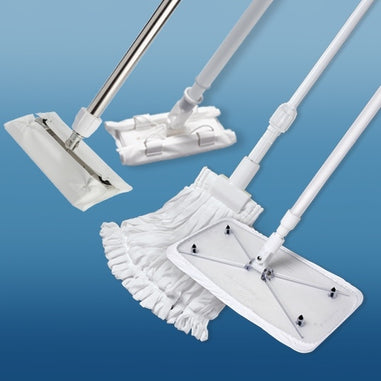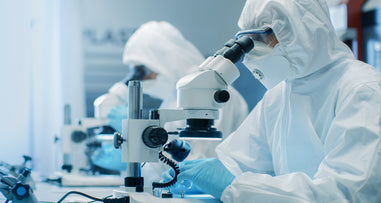- No products in the cart.
Cleanrooms are designed to maintain controlled environments by minimizing particulate, chemical, and biological contamination. However, even in meticulously regulated settings, contamination is a constant threat. Identifying the primary contamination sources and implementing preventive measures is crucial to maintaining the purity of the cleanroom environment. In this blog, we’ll explore the top contamination culprits in cleanrooms and offer practical tips on how to avoid them, along with the essential cleanroom supplies required to keep your cleanroom spotless.
Understanding Cleanroom Classes and Contamination Risks
Cleanrooms are classified based on the concentration of particles per cubic meter, with classifications ranging from ISO 1 (the cleanest) to ISO 9 (least stringent). In the context of particle contamination, cleanrooms are often referenced by their Federal Standard 209E equivalents, such as Class 10, Class 100, Class 1,000, and Class 10,000. Each class has specific particle count limits, where Class 10 allows no more than 10 particles of 0.5 microns or larger per cubic foot of air, while Class 10,000 allows up to 10,000 particles of the same size.
The tighter the cleanroom classification, the more stringent the controls need to be on factors such as personnel movement, equipment, air filtration, and cleaning protocols. For instance, in a Class 10 cleanroom, even a small lapse in protocol, like improper gowning or equipment not being adequately sterilized, could result in significant contamination. Meanwhile, in a Class 10,000 cleanroom, although the standards are less strict, the environment still demands careful control of air quality, material flow, and cleaning routines to prevent contamination that could affect sensitive operations.
When choosing cleanroom supplies and establishing protocols, it is vital to consider the class of the cleanroom, as the cleanliness standards directly influence the types of materials, garments, and cleaning processes needed to maintain compliance. High-efficiency air filtration systems, proper gowning, and the use of cleanroom-specific products become more critical as the class number decreases.
1. Personnel as Primary Contaminants
One of the most significant sources of contamination in cleanrooms is the personnel working inside them. Despite wearing protective gear, human activities such as talking, walking, or moving equipment can introduce particulates into the air. Skin cells, hair, sweat, and cosmetics can all become contaminants.
How to Avoid Personnel-Induced Contamination:
- Proper Training: Ensuring that all personnel are adequately trained in cleanroom protocols is the first line of defense. This includes understanding how their movements, actions, and personal habits can impact the cleanroom environment.
- Strict Dress Codes: Wearing appropriate cleanroom garments such as coveralls, hoods, masks, gloves, and shoe covers is essential. Personnel should avoid using cosmetics, lotions, or perfumes before entering a cleanroom.
Cleanroom Supplies:
- Cleanroom Garments: Cleanroom coveralls, hoods, and boot covers.
- Cleanroom Gloves: Nitrile or latex gloves that are low-lint and chemical-resistant.
- Masks and Hairnets: Disposable masks and hairnets to prevent particles from the face and hair.
2. Inadequate Air Filtration
Airborne particulates are a significant concern in cleanrooms, particularly if the air filtration system is not working effectively. Contaminants like dust, microorganisms, and fibers can infiltrate the cleanroom via air ducts or improper air handling systems.
How to Avoid Airborne Contamination:
- HEPA Filters: High-efficiency particulate air (HEPA) filters should be installed and regularly maintained. These filters trap even the smallest particles that could jeopardize the cleanroom’s cleanliness levels.
- Proper Airflow Design: Ensure that your cleanroom has the appropriate airflow design, such as laminar airflow, which helps move particles down and away from critical areas.
Cleanroom Supplies:
- Air Filtration Systems: Regular maintenance of HEPA or ULPA (Ultra-Low Penetration Air) filters.
- Air Quality Monitors: Tools to regularly check the particulate levels in the cleanroom environment.
3. Improper Cleaning Procedures
Using the wrong cleaning products or techniques can introduce more contaminants than they remove. Cleanrooms require frequent and rigorous cleaning to maintain their sterility, but the cleaning agents and tools used need to be specially designed for this purpose.
How to Avoid Contamination from Cleaning:
- Approved Cleaning Solutions: Only use cleaners specifically designed for cleanroom environments, such as isopropyl alcohol or hydrogen peroxide.
- Use of Proper Wipers and Mops: Instead of standard cleaning cloths, use lint-free wipes and mops that are specifically manufactured for cleanrooms.
Cleanroom Supplies:
- Cleanroom Wipes: Lint-free, non-shedding wipes like Texwipe.
- Cleanroom Mops: A cleanroom mop system such as the Texwipe AlphaMop, which is designed to clean surfaces without releasing fibers or particles.
- Cleanroom Vacuum: A vacuum designed with HEPA filters that can capture fine particles.
4. Contaminated Tools and Equipment
Any tools or equipment introduced into the cleanroom can bring in contaminants if not properly sterilized. This includes laboratory instruments, furniture, and electronic devices.
How to Avoid Equipment-Induced Contamination:
- Regular Cleaning and Sterilization: Ensure that all tools and equipment are thoroughly cleaned and sterilized before entering the cleanroom.
- Use of Dedicated Equipment: Limit the tools and equipment used in the cleanroom and dedicate them to cleanroom use only. Avoid transferring items between non-cleanroom and cleanroom environments.
Cleanroom Supplies:
- Sterilizers: Autoclaves or chemical sterilizers.
- Cleanroom Furniture: Furniture designed for cleanroom use, such as stainless steel tables and benches that are easy to clean and sanitize.
5. Inadequate Containment of Materials
Materials brought into a cleanroom, such as chemicals, raw materials, or packaging, can introduce contaminants if not appropriately handled. Packaging materials, in particular, are a common source of particulates.
How to Avoid Contamination from Materials:
- Proper Material Handling: Implement strict protocols for bringing materials into the cleanroom. This includes double-bagging materials and wiping down packages before they enter the cleanroom.
- Use of Cleanroom-Safe Packaging: Always use cleanroom-grade packaging for transporting and storing materials.
Cleanroom Supplies:
- Cleanroom Packaging: Double-bagged, low-particulate materials and containers.
- Material Pass-Throughs: Specialized pass-through chambers for safely introducing materials into the cleanroom.
6. Poor Maintenance of Cleanroom Garments
Garments used in cleanrooms, such as gloves, gowns, and masks, can become contaminated if not properly maintained. Reusable garments, if not laundered and sterilized correctly, can introduce contaminants back into the cleanroom.
How to Avoid Garment-Induced Contamination:
- Single-Use Garments: Where possible, opt for disposable garments to minimize the risk of contamination.
- Proper Laundering: If reusable garments are employed, ensure they are cleaned using specialized cleanroom laundry services that adhere to strict decontamination protocols.
Cleanroom Supplies:
- Disposable Cleanroom Apparel: One-time-use coveralls, gloves, and masks.
- Specialized Laundry Services: For laundering reusable garments in a contamination-controlled facility.
7. Human Traffic and Material Flow
The movement of personnel and materials in and out of the cleanroom can significantly increase contamination risks. Every time a door is opened, particles from the outside can flow into the cleanroom, and human activity can stir up dust and particles.
How to Avoid Contamination from Traffic:
- Controlled Access: Limit access to the cleanroom and create a clear pathway for personnel and materials.
- Air Showers and Sticky Mats: Use air showers at the entrance to blow off loose particles, and sticky mats at doorways to remove contaminants from shoes.
Cleanroom Supplies:
- Sticky Mats: Placed at entrances to remove contaminants from footwear.
- Air Showers: To remove particles from personnel and equipment before entry.
Conclusion
Maintaining a contamination-free environment in a cleanroom requires vigilance, proper equipment, and the right supplies. By understanding the top sources of contamination and investing in the correct cleanroom supplies, such as specialized garments, cleaning tools, and air filtration systems, you can significantly reduce the risk of contamination. With consistent effort and adherence to protocols, you’ll ensure your cleanroom stays clean, compliant, and efficient for its intended purpose.
For over 45 years, Lab Pro Inc. is your steadfast source for premium cleanroom supplies, hand tools, lab equipment, chemicals, and PPE apparel. Trusted by aerospace industries, medical device companies, and laboratories globally, we epitomize exceptional quality in every product. Experience the convenience of next day service in California. Contact us online or at 888-452-2776 to explore solutions tailor-made for the laboratory industry. Elevate your experiments with Lab Pro Inc. – your partner in precision and excellence.












































